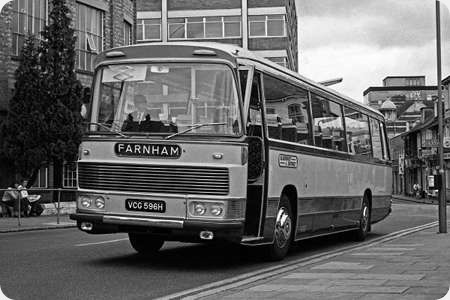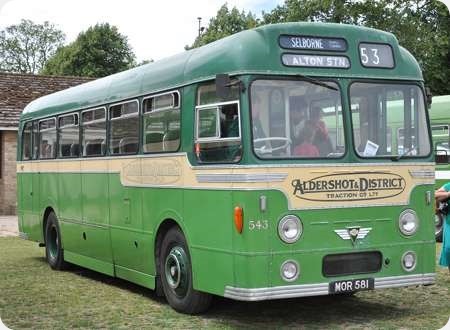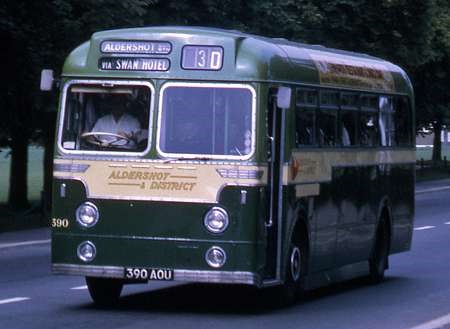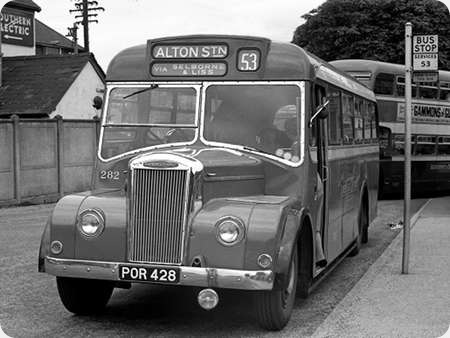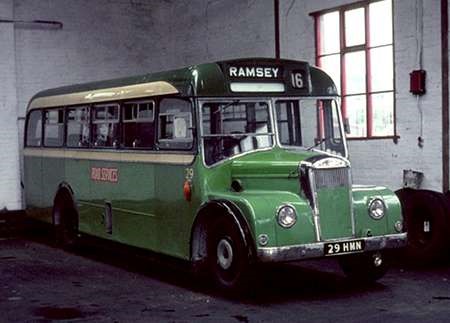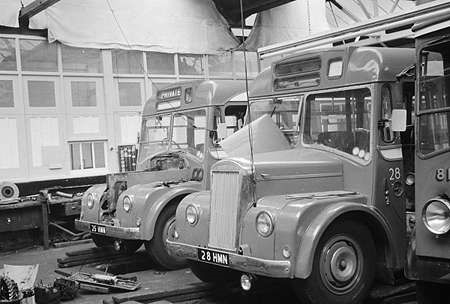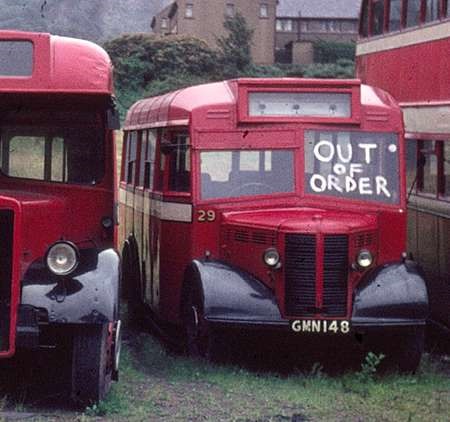Aldershot & District – AEC Reliance – VCG 596H -596
Aldershot & District Traction Co
1970
AEC Reliance 6U3ZR
Duple C49F
Having vacillated for some time before settling upon an underfloor engined saloon chassis, even buying some full fronted Dennis Lancet III coaches in 1953, Aldershot & District finally chose the AEC Reliance as its standard single decker, and stayed with this model for its coach requirements right up to its subjugation to Thames Valley (mis)management from January 1972 under the new guise of Alder Valley. Seen here in The Grove alongside Aldershot Bus Station is No.596, VCG 596H, the first of four 6U3ZR Reliances supplied in 1970 with Duple C49F coachwork sporting the (to my eye) hideous Detroit “inspired” front grille that spoilt many of the later Duple designs. Aldershot & District bought two more Reliances of the 6U3ZR specification in 1971, but these had the aesthetically more pleasing Plaxton C49F coachwork. VCG 596 passed to Alder Valley from 1 January 1972 as No. 49.
Photograph and Copy contributed by Roger Cox
22/12/18 – 06:37
I have to say that I like this coach! Functional, neat without meaningless frippery: where is the Detroit? Burlingham, Whitson, Yeates, other Duple perhaps…this is more Turin!
Joe
22/12/18 – 12:11
Joe – the "Detroit"-inspired part is the full-width chromed grille, which does look rather "overpowering" to my eyes. The chromed strip that runs the length of the body and at across the front at headlight level is also an excessive amount of polished metal.
In a monochrome photo, and wearing a livery with various colours, it doesn’t look so bad, but with a different "livery", and in colour, the effect is pretty dire:- https://thetransportlibrary.co.uk/index.php
I see from other photos that Southdown had the sense to specify their RUF-H batch of Leopards with the same body without the chromed strip on the sides, but they were stuck with the grille.
The polished metal soon went out of fashion, but the advent of the Dominant with curved side windows made the Commander look very old-fashioned in just a couple of years.
Nigel Frampton
26/01/19 – 06:48
The 36ft long AEC Reliance with the AH691 engine & the later AH760 power unit was a real drivers coach & the best premium weight coach on the market until the Volvo B58 surpassed it. With a Reliance the only thing to watch is they tended to run a bit hot on sustained motorway journeys. My boss instructed his drivers to keep an eye on the temperature gauge & if it starts to climb, drop a gear & keep it down to 55 to 60 MPH while it drops. Good advice, never had overheating on later Reliances.
Leyland Leopard, very good, but I think the chassis was more suited to a service bus body rather than a premium coach. As a coach, the gear ratios were all wrong on a semi auto Leopard, but in terms of reliability & strength of the chassis they were unsurpassed.
Andrew Spriggs
26/01/19 – 09:59
Not sure about the overheating: if you had a Sunbeam Imp with the usual gasket problem, going faster improved the air cooling effect!
Joe
06/03/19 – 07:17
I think the overheating problems associated with the Reliance were mainly confined to the wet lined AH470 engine, later replaced by the more successful, dry lined AH505.
The least said about the Hillman Imp, especially the very early examples, probably the better.
John B
26/09/19 – 05:53
I have always seen what you refer to as the Detroit-style grille (I have to agree with Joe that it is more Turin than Detroit) as a clean and elegant successor to the grimace-like grille applied to later Bella-series Duple bodies, itself a massively disappointing successor to the original Bella grille which to my mind was a natural update to the earlier butterfly design.
John Kemplen
Quick links to the - Comments Page - Contact Page - Home Page
